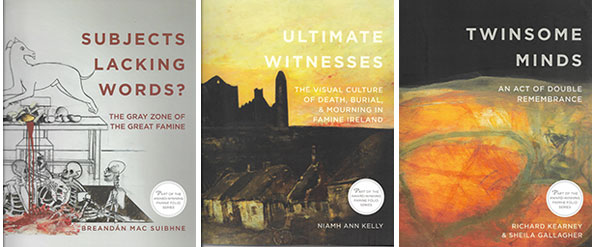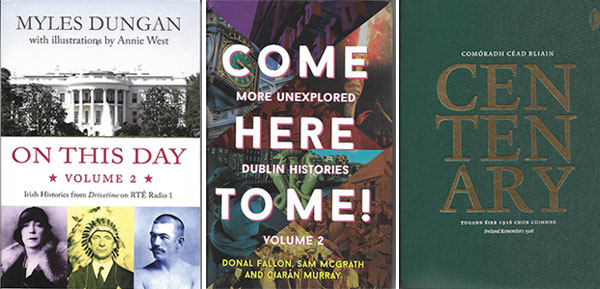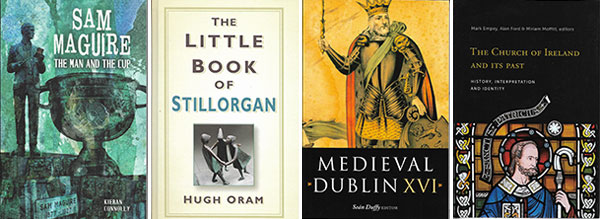BOOKWORM
Published in Book Reviews, Issue 1 (January/February 2018), Reviews, Volume 26By Joe Culley
Breandán Mac Suibhne, Subjects lacking words? The gray zone of the Great Famine (Cork University Press, €11.95 pb, 48pp, ISBN 9780997837476).
Niamh Ann Kelly, Ultimate witnesses: the visual culture of death, burial and mourning in Famine Ireland (Cork University Press, €11.95 pb, 48pp, ISBN 9780997837469).
Richard Kearney and Sheila Gallagher, Twinsome minds: an act of double remembrance (Cork University Press, €11.95 pb, 48pp, ISBN 9780997837452).
Myles Dungan (with illustrations by Annie West), On this day, volume 2: Irish histories from Drivetime on RTÉ Radio 1 (New Island, €10.95 pb, 340pp, ISBN 9781848406360).
Donal Fallon, Sam McGrath and Ciarán Murray, Come here to me! volume 2: more unexplored Dublin histories (New Island, €19.95 hb, 320pp, ISBN 9781848406339).
Ronan McGreevy (ed.), Centenary/Comoradh céad bliain (Government Publications, €24.99 hb, 388pp, ISBN 9781406429435).
Kieran Connolly, Sam Maguire: the man and the cup (Mercier Press, €12.99 pb, 190pp, ISBN 9781781175095).
Hugh Oram, The little book of Stillorgan (History Press Ireland, €14.99 hb, 144pp, ISBN 9780750983532).
Seán Duffy (ed.), Medieval Dublin XVI (Four Courts Press, €24.95 pb, 328pp, ISBN 9781846826047).
Mark Empey, Alan Ford and Miriam Moffitt (eds), The Church of Ireland and its past: history, interpretation and identity (Four Courts Press, €55 hb, 310pp, ISBN 9781846826375).
In his 1986 classic The drowned and the saved, detailing his time in Auschwitz, Primo Levi coined the phrase ‘the gray zone’ to describe how the inhabitants of the camp ‘could not be reduced to two blocs of victims and persecutors’. Instead, even though they were wearing ‘the same striped tunic’, many prisoners collaborated with their captors. In this gray zone, this moral space, the saved ‘may not be the best’ but rather ‘the selfish, the violent’.
According to Breandán Mac Suibhne, ‘The gray zone of the Great Famine is the demi-monde of the soupers and grabbers, moneylenders and meal-mongers, and those among the poor who had a full pot when neighbours starved’.

Also in the folio series is Niamh Ann Kelly’s gorgeous Ultimate witnesses: the visual culture of death, burial and mourning in Famine Ireland, which includes reproductions of Burton’s 1841 The Aran Fisherman’s Drowned Child and Muriel Brandt’s 1946An Gorta. ‘The devastation of disease, the pace of death and fears of contagion not only altered the practices of mourning and burial during the calamitous height of the Famine, but have also shaped its visual representation and ongoing patterns of remembrance.’

In a similar vein of intriguing historical titbittery, Myles Dungan has collated volume two of his popular On this day on RTÉ Radio 1’s Drivetimeprogramme. It is again illustrated by Annie West. You’ll learn the tale of moonshiner Katie Daly, remembered in song and the only female inmate of Alcatraz; that Barry Fitzgerald decapitated his Oscar for Going My Way; and that Sir Eyre Coote was rather fond of, well, discipline. Two complaints: there is no table of contents, and—much more inexcusable—West’s illustrations are in black and white. That’s like looking at a pencil sketch of Van Gogh’s sunflowers.
As part of this decade of commemorations, the Government Publications Office has issuedthe official (and monumental) Centenary: Ireland remembers 1916. In his opening remarks, the editor,Irish Times journalist Ronan McGreevy, explains that ‘it is not a book about 1916. It is a book about how 1916 was remembered 100 years on. Nor is it a book exclusively about the commemorations to mark the Easter Rising … It also includes the First World War and, in particular, the centenary of the Battle of the Somme.’ It includes nine photo-essays. It is, really, in the best possible sense, a souvenir of the time. It is a most handsome work, whose worth will become more clear with each passing year.

Hugh Oram continues his little series on the neighbourhoods of southside Dublin with The little book of Stillorgan. Clearly a niche subject, ‘you will discover Stillorgan’s rural past, its famous sons and daughters, its churches, pubs … sporting heritage and its natural history. You will also glimpse a darker side to Stillorgan with a look at crime and unrest in the district.’
Kieran Connolly has produced the very readable Sam Maguire: the man and the cup. Connolly, who, like his subject, is originally from West Cork, tells the tale of Maguire, this leading member not only of the Cork mafia in the Post Office in London but also of the GAA and IRB in the city. The second half of the book recounts some of the significant moments involved in winning the cup.
The sixteenth edition of Medieval Dublin is a collection of essays taken from the 2014 conference at Trinity College, Dublin, marking the millennium of the Battle of Clontarf. Produced by Dublin City Council and edited by our own Seán Duffy, the volume sheds ‘new light on the role of the Vikings in medieval Ireland, dispelling (and in some cases reconfirming) myths, and raising public awareness. It seeks to bring us closer to establishing what really happened at the battle of Clontarf (essays by Etchingham, Ní Mhaonaigh and Halpin), to re-evaluate the origins of Brian Boru (Jaski and Swift) and his career (Bhreathnach, Casey, O’Flynn, and Wadden), his dynastic legacy and his later literary image (Fischer and Ní Úrdail)’.
Another impressive volume of essays is The Church of Ireland and its past: history, interpretation and identity, a comprehensive collection edited by Mark Empey, Alan Ford and Miriam Moffitt. For a dissenting voice on (some) of its contents see this issue’s Platform, pp 14–17.
















